Expanding on the above, consider the risks from "traffic analysis", "envelope" data, and network theory.
![Tinfoil Hat [tinfoil] [tinfoil]](/xen/styles/default/xenforo/smilies.vb/tinfoilhatsmile.gif)
There's significant intelligence to be gleaned
even without decryption, just from volume of traffic and knowing who is talking to whom (every transmitter or Telegram user or phone has a unique fingerprint). Over a longer period, time-data series can reveal hierarchy and command structure -- where do orders originate, how are they distributed to the various cells and members? Are there highly-connected critical nodes, or sub-graphs with very limited connectivity to the main group? (Each a weak point in its own way).
Long before Facebook, various TLAs were deeply invested in researching Social Network Analysis (SNA) and social graph theory. Convenient that we are volunteering to fill in the network/graph for them these days

If you're interested in open datasets for experimenting with social graph tools, one interesting set of data to learn on is "
The Enron Corpus", a freely available database of ~600,000 emails generated by 158 employees of the Enron Corporation in the years leading up to the company's collapse (12/2001) and made public by UMass-Amherst.
For some visualizations, see
Using social network analysis measures - Cambridge Intelligence

![Tinfoil Hat [tinfoil] [tinfoil]](/xen/styles/default/xenforo/smilies.vb/tinfoilhatsmile.gif)


